Carlos Benoit looks back on 50 years of gardening
23/12/2024 - 16:27
We visited Carlos Benoit, a retired landscaper from Waregem, in Belgium and the driving force behind Tuinen Benoit (Gardens Benoit) for over half a century. Our conversation with this third-generation gardener was truly fascinating. His family is likely among the first garden contractors in Waregem, a town that also happens to be the hometown of TerraCottem's founder, Bernard Devos. During our talk, it became clear that Carlos is among the first adopters of TerraCottem, further underscoring his pioneering spirit in the field.
| Interviewer: Davy Ottevaere, Technical Manager TerraCottem BV |
Hi Carlos, how long have you known TerraCottem?
Quite a long time! Bernard Devos, the father of your managing director Carol Devos, used to live with his family on the grounds of the Potegem estate in Waregem. I maintained that garden for over 25 years. It was during that time that I also got to know Professor Willem Van Cotthem, who occasionally visited there.
What period are we talking about?
It must have been the early 1990s. I still remember those first trials in Burkina Faso and other projects. The professor enjoyed talking about them (laughs). I recall him mentioning a ‘failed’ trial where trees were blown over because the planting holes weren’t big enough. That experience inspired me to start paying much closer attention to creating optimal planting holes: sufficiently large and enriched with proper soil improvement.
| Want to read more about the history of TerraCottem? Read the unique story here. |
|---|
 |
| Or are you looking for more information on the ideal size of planting holes? Read our tips here. |
|---|
 |
First things first: tell us, who is Carlos Benoit?
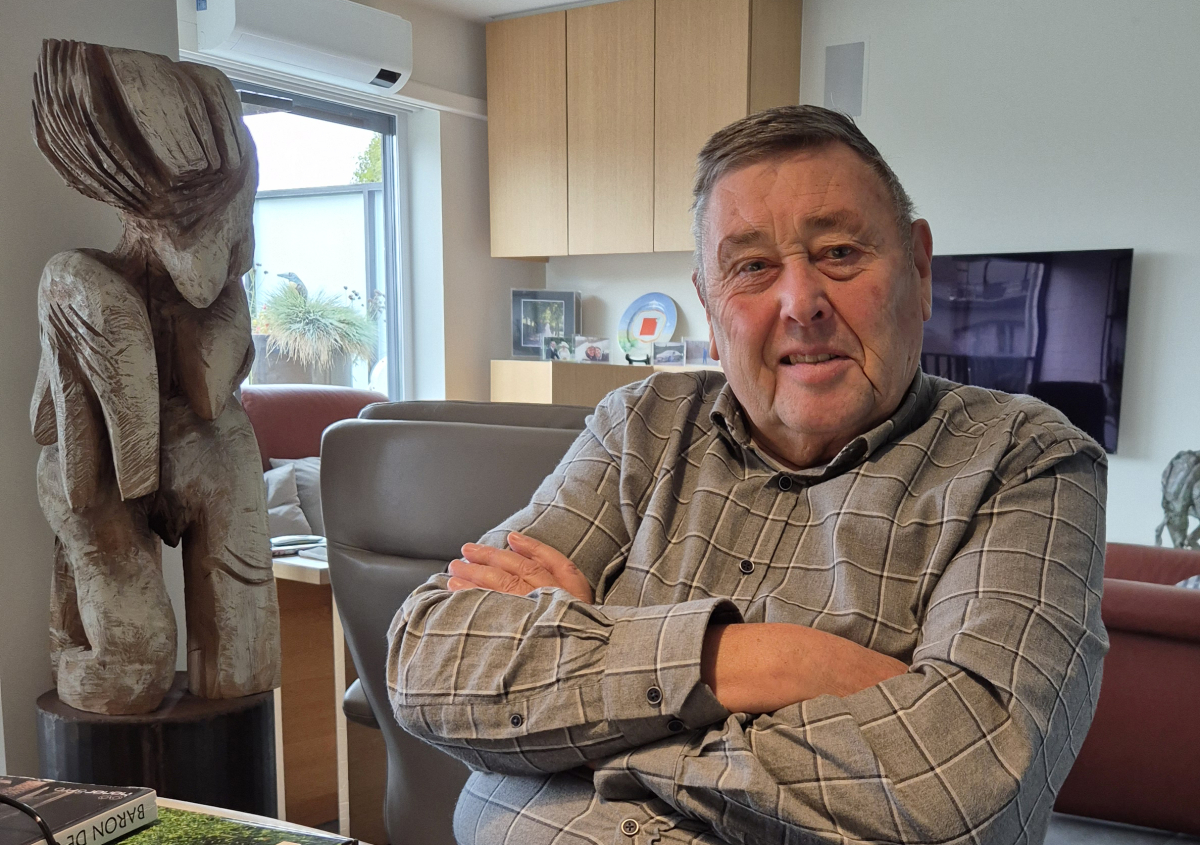 |
In 1970, I started working for my father, who was a gardener and plant grower himself. I had then just graduated from horticultural school, as a landscaper. In total, I worked for my father for four years. |
My father’s clients included the OCMW (Public Centre for Social Welfare) of Waregem. When I started on my own, I received this client as a ‘starting gift.’ That immediately gave me a big boost as a self-employed professional (laughs). On its management board was Mr. Valère Devos, Bernard’s father and Carol’s grandfather. That’s how I got to know him and was given the opportunity to maintain the garden of the Potegem estate. The management board also included several other Waregem entrepreneurs, many of whom became my clients as well.
When I started in 1974, my father and I were actually the only gardeners in Waregem. Most of the landscaped gardens from that period were built and maintained by us.
Was it a coincidence to have clients with big gardens?
Not really. It was simply because those gardens were often talked about in those circles, and one thing led to another. These clients gave me the opportunity to create truly incredible gardens.
And it also allowed me to collaborate with brilliant landscape architects, such as Vincent Verlinden from Knokke and Lieven Vereecke from Aalter. And, for example, Jacques Wirtz from Schoten. These are truly renowned names in our field.
So, you were essentially spoon-fed everything related to gardens, considering your grandfather was also a gardener?
Yes, that’s right. I am proudly a third-generation gardener of the Benoit family.

When I was 10 years old, I was already pulling my weight in our greenhouses—sorting pots, potting plants, and so on. Attending horticultural school was the only logical choice for me. During the summer holidays, the first week was for putting away my school bag and the last week for dusting it off again (laughs). In between, I spent my time helping with garden maintenance, mowing lawns, and other tasks.
Your father was also a plant grower?
Yes, indeed. We had several greenhouses where we grew plants and flowers ourselves, which we then sold in our shop, ‘Bloemenweelde’. Naturally, we also used some of our plants in the gardens we worked on.
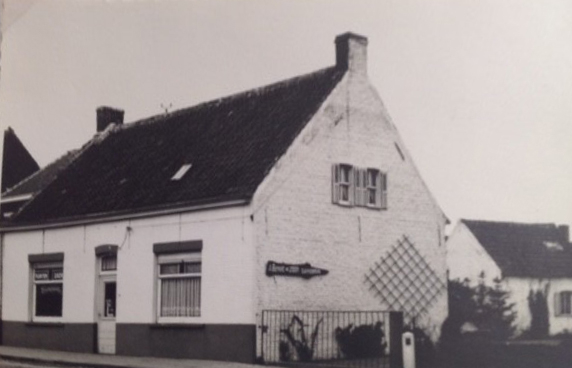
My grandfather started that on a very small scale. As a landscaper with about four clients, he had his own little greenhouse. My father took over and took things a step further - making everything just a bit bigger.
And you went one step further, turning Gardens Benoit into a household name in the region...
When I graduated from horticultural school, I was young and very ambitious. I wanted to invest and expand, but my father was somewhat hesitant. After a few years, I decided to start my own business. As I mentioned earlier, the contract with the Public Centre for Social Welfare in Waregem was a wonderful starting gift.
I became responsible for maintaining all the gardens owned by the centre, which kept me very busy right from the start (laughs). Then the Potegem gardens were added, and from there, it just kept growing and growing.
A few years ago, I created a book called Gardens Benoit. It’s filled with many photos of the beautiful gardens I’ve built, along with the sketches for those projects. It also includes a brief account of my life story, much like the one I just shared with you.
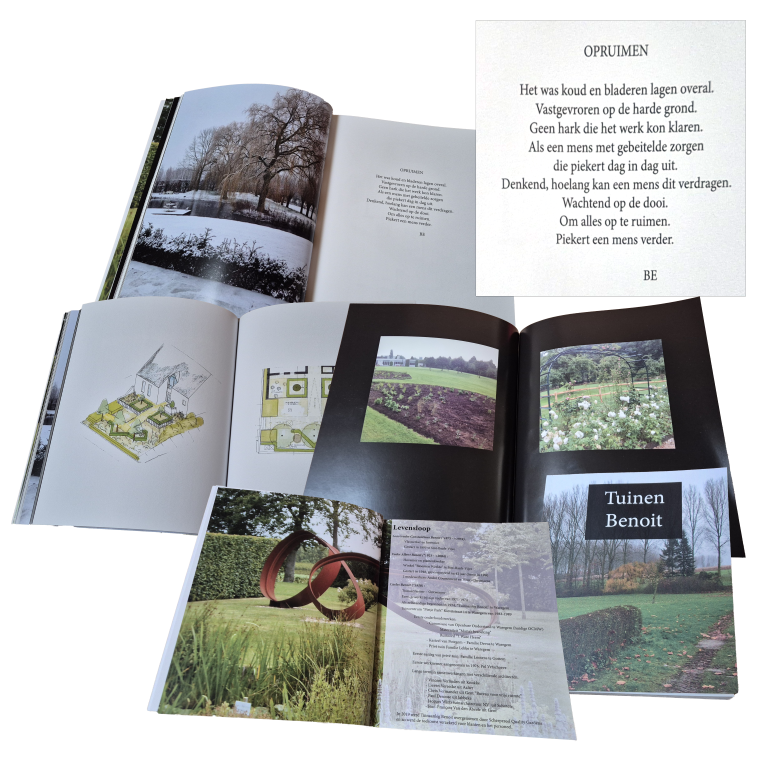
By the way, throughout the book there are also many poems. Several by your former colleague Gilbert Vangampelaere.
| Late last year, we had the pleasure of visiting Gilbert Vangampelaere. Read our conversation with TerraCottem's very first production manager here. |
|---|
 |
What was the reason for making this book?
It wasn’t for publication or anything like that—it was more for myself. I also gave a copy to all my clients and to everyone who has ever worked for me. And there were many!
Impressive! You started out as a sole proprietor, but obviously it didn't stay that way?
No, I started out on my own. But by the time I retired, Gardens Benoit had grown to a team of 12 employees.
Gardening in general was also becoming increasingly popular in the region. I witnessed the rise of some larger players, such as Arbowar in Waregem and Silvère Vandeputte in Deerlijk.
Over the years, seven of my former employees also started their own businesses, all in Waregem. Garden construction and maintenance really flourished during my active career, and I’m proud to have been part of that growth.
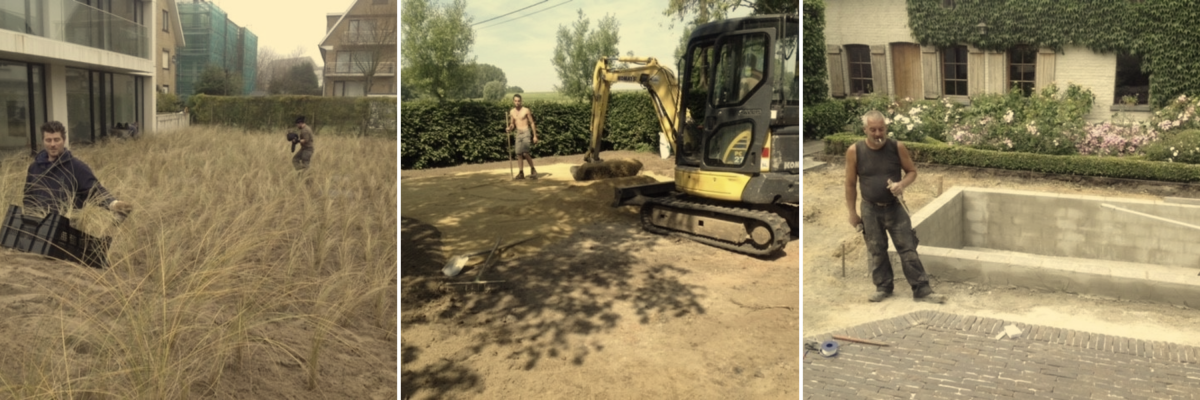
You have a degree in landscaping yourself?
Yes, but I didn’t actually design many gardens myself. I did design some smaller ones, but the really big gardens were designed by renowned landscapers.
Advertising was never something you had to do?
I never advertised in my life. The only advertising I ever had was the lettering on my van. That’s it. And I never had a shortage of work.
You ended up working in the landscaping industry for more than 50 years. I suppose a lot has changed during that time?
Absolutely, especially when it comes to digitalisation. Back in the day, I had to gain my knowledge from school, books, or directly from growers and other sources. Now anyone can pull out their smartphone and find the information they need in seconds.
The customers have also become much more informed. They often do their own ‘research’ beforehand and come to me with specific ideas or requests.
Do you remember one of those very first TerraCottem applications?
Yes, I do. I met Frédéric Cras, the general manager of Cras Woodgroup in Waregem. He had built a square farmstead around a very large willow in the courtyard. Unfortunately, the four-year construction project had taken its toll on the tree. It didn’t survive the ‘hardships’ it endured, such as soil compaction from excavators and cement residues left behind by mixers. As a timber merchant, that tree was a key feature for Frédéric, and he wanted a replacement that would make an immediate statement. So, it had to be a big tree (laughs).
We traveled together to the Van Den Berk tree nursery in the Netherlands and selected a 35-year-old English oak (Quercus robur). The tree weighed 8,000 kilograms and required special transport to move it. Finally, a large crane lifted it into the courtyard, and it was planted in a specially prepared planting hole enriched with TerraCottem.
That was a very expensive tree—many tens of thousands of Belgian francs at the time. We simply couldn’t afford it not to take root, which is why we used TerraCottem.
Those are such fond memories. Even now, when I drive past and see the tree towering above the roof, I’m reminded of that project.
I also have another tree like that in Sint-Baafs-Vijve, at Wakkensesteenweg. It was planted with TerraCottem in 1985. It’s a Robinia pseudoacacia ‘Frisia’, an acacia with beautiful yellow leaves.
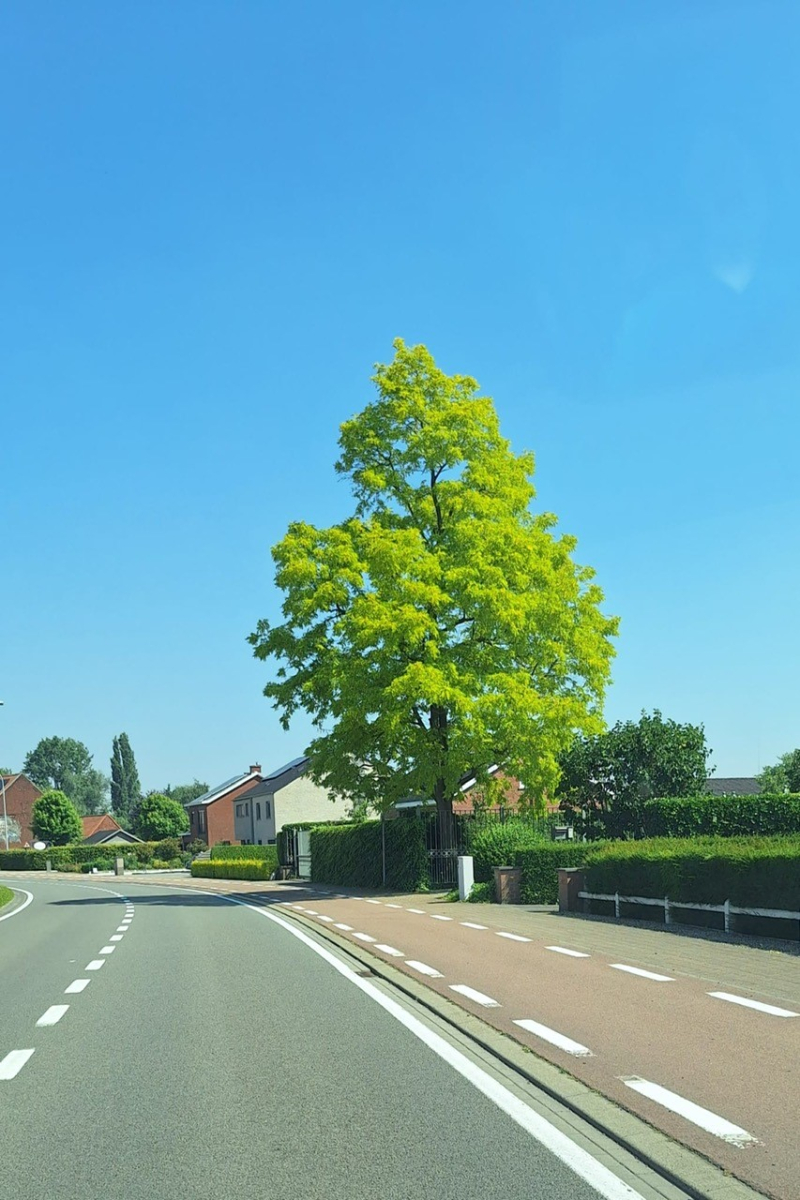
When you planted those big trees, why did you use TerraCottem?
Because I was convinced! Partly because of my conversations with Bernard and Professor Van Cotthem—their explanations were very clear. But also, because I saw the results myself. My plantings had little to no failures, and I noticed that I needed to water less than I initially expected. That success reinforced my belief in it.
"For myself, it was a form of reassurance to use TerraCottem".
Because I gave a guarantee to my clients, I often had to check whether the plantings were getting enough water in the early stages. Ideally, the customers should have taken care of this themselves, but in practice, that rarely happened. Thanks to the TerraCottem in the soil, I felt reassured: the plants required less water overall, and if they ‘forgot’ to water once, it wasn’t a big problem.
"But I didn’t use TerraCottem just for its water retention benefits. It also contains fertilisers, which works effectively, and raw materials that promote better root growth".
By the way, the explanations I received were very useful in discussions with my own clients. That said, I never really had to make much effort to convince them of the added value (laughs).
Did you often have discussions with clients about which resources to use?
Actually, no. I usually had those conversations with the landscape architect and we always came to an agreement very quickly. For example, when it came to TerraCottem, I used it in almost all my projects. The garden architect was always convinced of its added value.
When you started 50 years ago, there was no TerraCottem. What did you use then?
Peat. My grandfather used a lot of peat, my father used a lot of peat, and so did I (laughs). Peat can hold moisture, but you really can’t compare it to TerraCottem. That’s on a completely different level.
Did you notice an evolution in the challenges you faced over those decades?
Absolutely. In the past, the challenges were more ‘logistical’. Things like ‘my grass is tall, when will you come to cut it?’ or ‘when can you trim my hedge?’. Sometimes, you just couldn’t keep up (laughs). Now, the problems are more ‘technical’, with issues like drought and plant diseases becoming much more common.
What has also changed is that people now ‘know more.’ They have access to all the information—through Google, ChatGPT, and so on.
The landscaper used to have all the knowledge, and the client... was just the client, you mean?
Exactly! And that has made people more demanding. Now, much more time and energy are spent prior to the actual construction or maintenance.
And now, after half a century of garden landscaping and maintenance, you’ve gone on a well-deserved retirement. You’ve sold your business?
Yes, indeed. Gardens Benoit was taken over by Koen Scherpereel of Scherpereel Quality Gardens. Koen was my neighbour, so I knew him well. He originally started as a nurseryman but wanted to expand his services to include landscaping.
I stayed on for another six months to ensure a smooth transition, but then it was over (laughs).
Your children didn’t follow in your footsteps?
My eldest daughter graduated as a landscape architect, but she never pursued it. She’s now the branch manager of the Aldi store here in Waregem. My youngest daughter works as a nurse at a retirement home, and my second is a podiatrist with her own practice. So, they’ve all taken completely different paths.
What do you do now to fill your days?
I still keep in touch with many of my old clients. They often call me for advice, but I don’t actually work in gardens anymore. I leave that to Koen. Still, I really enjoy sharing my expertise and helping where I can.
I also spend a lot of time hiking—it’s something I really enjoy. Plus, a few months each year, we stay in Spain, in Torrevieja, a lovely spot in Alicante.
Do you have, or did you have, a favourite plant that often featured in your projects?
I’ve always been a big fan of boxwood. And when the buxus plague started to take over, I shifted to its replacement: Osmanthus. Why? Because you can shape it into all sorts of forms. Those shapes became recurring elements in many of my gardens.
Well, Carlos, all that’s left is to thank you. I really enjoyed our chat, and I’m sure our readers will too.
Thanks. It was great to share some memories!
If you know someone who would also like to read this article, feel free to copy the link and share.
Would you like to be in the spotlight too?
You can!
Send a quick email to marketing@terracottem.be and we will schedule an online meeting together.
Would you also like to use TerraCottem in your projects?
Let's ConnectWould you also like to use TerraCottem in your projects?
Let's ConnectTerraCottem Intl. SL
Apartado de Correos 4511190 Benalup (Cádiz)Spain

